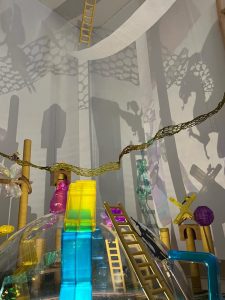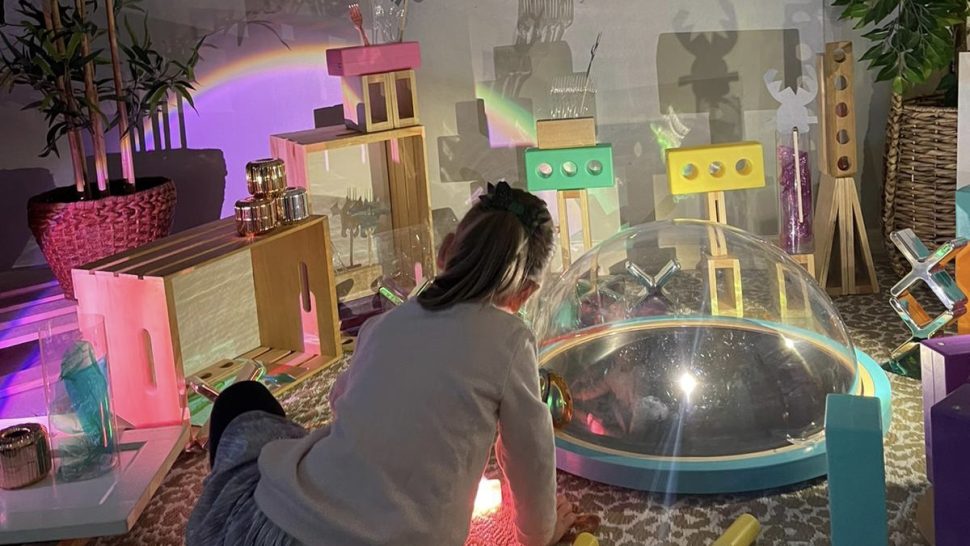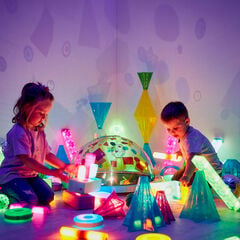Our experience of the Immersive Projector
A child can learn the differences between light and shadow by exploring, observing, and creating with the use of materials within their reach. These materials enable them to reason, understand, and explain the intention of a phenomenon like the one we had the opportunity to observe and experience today.
One of the major benefits observed while using this interesting projector was how it called the children’s attention to the natural game of light and shadow. Through our research, we have learned how this type of play is broad in nature, bringing benefits to children of different ages that are intrinsically interested in the properties of light and shadow.
Our goal for integrating the projector into the children’s play was for them to use their imagination by creating stories with all the materials that were around them. Through our observations, we were in awe of the wonder and discovery expressed by the children, highlighting all the possibilities of their creativity and imagination.
Note: children of different ages participated in this invitation. Interestingly, each of the children seemed to find different functions for the projector when integrating it into their exploration.
Observations
We would like to highlight how interesting it was to witness the interactions between two siblings of different ages, Greyson, three years old, and Reagan, one-year-old. Throughout their interactions, Greyson took on the role of teaching and supporting his younger sister in this exploration, showing her what he had discovered and supporting her when she needed it.
First Group
Collaborative/Parallel Play: Greyson, three years old – Reagan, one-year-old (siblings)
At first glance, as both began to manipulate the materials, they seemed to be collaboratively playing together. Through the use of materials, Greyson discovered how he could create shadows on the wall and the ceiling by placing materials on the projector. He expressed great amazement and joy through the expressions on his face. He then invited his sister to observe the shadow projected on the ceiling when he placed a monster puppet against the projector.
Solitary Play
It was possible to observe how Greyson integrated different types of monster puppets and other materials into the light of the projector to observe the shadow that was projected. Reagan enthusiastically observed her brother’s play, observing him carefully. At one point, she tried to move the monster puppets herself, focusing her eyes on the light. When her brother pointed out the shadow around her, she looked at him and smiled.
Second Group
Collaborative Play: Ellia and Gabriel, three years old.
In a positive and fun interaction, they shared with each other what they discovered while interacting with the materials. Using the projector as support, they managed to create shadows with the blocks and the paper in a game full of discoveries.
Solitary Play
Gabriel was always aware of the projector and its surroundings, integrating the walls and ceiling into his exploration. He was observed placing monster puppets and letters on the projector, maintaining his focus on where the shadow would appear and the effects his movements had on the shadow. There were moments where he felt comfortable with the projector, slipping and sliding along its dome. He was also interested in touching the projector, engaging in cause and effect as he turned the power button on and off to see what happened.
Ellia: Upon joining the invitation, the projector held the letters of the word “monster”; she was on the opposite side of where they were placed. When she noticed them, she asked Gabriel to pass her the letter “E,” which is the first letter in her name. However, she was actually asking for the letter “M,” which resembled the “E” when tilted on its side. She then placed it on the projector and asked for a piece of paper, which she used to make a shadow. As she observed the shadows on the paper, excitement spread across her face.
Third Participant: Amelia, five years old
Upon entering the invitation, she began to integrate the monsters into her play, creating a story with them, “This one is a boat, and the monster goes in it.” Shortly after making her boat using blocks, she placed it on the projector expressing, “The projector is the planet where the monster lives.” She kept the boat on the projector and then began to create a bed around it where the monster family could sleep. While she interacted with all these materials, she discovered her reflection on the projector. From that moment, she began to use the projector as a mirror, placing different materials against it to observe them through their reflection.
General Observations
Through our observations, we realized how some of the children who participated perceived the movement of the shadow. In doing so, they were aware of the light from the projector as an individual stimulus. Through their interactions, they also discovered new functions for the projector, such as the mirror effect that Amelia found, or as an element to a story, such as a planet for the monsters. Furthermore, Gabriel and Ellia explored the special orientation created by hovering over it and looking through the other side while being aware of their shadows.
It is important to highlight how sometimes the ages of the children intervene in the development of their play. In other words, how they play changes as children develop cognitively, emotionally, and socially. We were able to observe this as we witnessed how some of the children played individually, some played parallel, and others played cooperatively. There were observable differences between them, where variables such as age and the emotional bond of the children could be taken into account.
Observations and importance of the material
An important aspect worth highlighting is the great potential we see in the projector as a resource for play invitations. It is a resource that provides excellent benefits for visual stimulation and the development of the cognitive area, leading children to make innumerable connections and observable mental processes through the creativity expressed in their configuration of play. It also invites the development of language, which was highlighted when we observed how the children created, elaborated, and narrated stories around the projector (Storymakers).
Skills and Standards Observed:
✔Coordination of movements
✔Concentration and focus
✔Problem-solving
✔Cause and effect
✔Object permanence
✔Curiosity and interest
✔Properties of light and shadows
✔Hand-eye coordination
✔Cognitive development
✔Visual-motor coordination
✔Creativity and Inventiveness
✔Imaginative and creative play
✔Creative movement
✔Imaginative and creative play
✔Oral language
✔Spatial relations
Many thanks to Paola Lopez for writing this article for us.
Paola Lopez is the Founder & Executive Director at Kinderoo Children’s Academy, Inc. Kinderoo Children’s Academy is a state-licensed and -accredited Gold Seal Preschool and Toddler Early Learning Center serving children ages 12 months-5 years of age. They offer full and part-time school-year programs, drop-in care, and both summer & winter camps. Their high-quality environments for young children enhance development and lay the groundwork for happy, healthy, and productive futures, and their teachers provide authentic experiences that are relevant to children’s daily lives.









